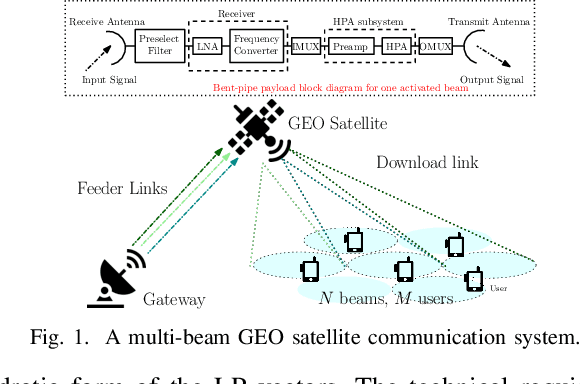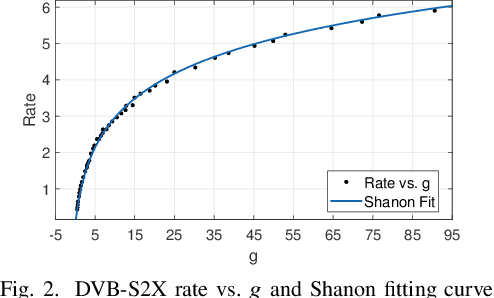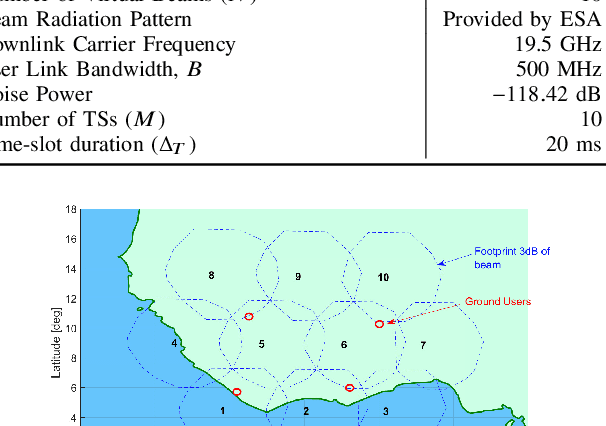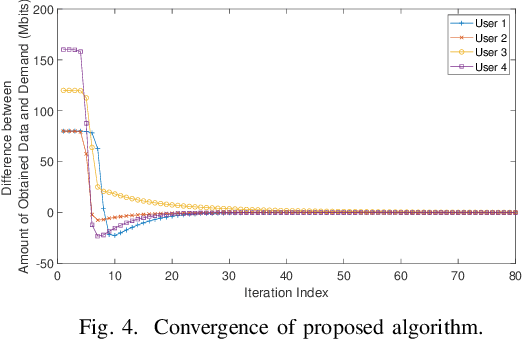Juan Carlos Merlano Duncan
Artificial Intelligence implementation of onboard flexible payload and adaptive beamforming using commercial off-the-shelf devices
May 03, 2025Abstract:Very High Throughput satellites typically provide multibeam coverage, however, a common problem is that there can be a mismatch between the capacity of each beam and the traffic demand: some beams may fall short, while others exceed the requirements. This challenge can be addressed by integrating machine learning with flexible payload and adaptive beamforming techniques. These methods allow for dynamic allocation of payload resources based on real-time capacity needs. As artificial intelligence advances, its ability to automate tasks, enhance efficiency, and increase precision is proving invaluable, especially in satellite communications, where traditional optimization methods are often computationally intensive. AI-driven solutions offer faster, more effective ways to handle complex satellite communication tasks. Artificial intelligence in space has more constraints than other fields, considering the radiation effects, the spaceship power capabilities, mass, and area. Current onboard processing uses legacy space-certified general-purpose processors, costly application-specific integrated circuits, or field-programmable gate arrays subjected to a highly stringent certification process. The increased performance demands of onboard processors to satisfy the accelerated data rates and autonomy requirements have rendered current space-graded processors obsolete. This work is focused on transforming the satellite payload using artificial intelligence and machine learning methodologies over available commercial off-the-shelf chips for onboard processing. The objectives include validating artificial intelligence-driven scenarios, focusing on flexible payload and adaptive beamforming as machine learning models onboard. Results show that machine learning models significantly improve signal quality, spectral efficiency, and throughput compared to conventional payload.
Optimal Linear Precoding Under Realistic Satellite Communications Scenarios
Aug 16, 2024Abstract:In this paper, optimal linear precoding for the multibeam geostationary earth orbit (GEO) satellite with the multi-user (MU) multiple-input-multiple-output (MIMO) downlink scenario is addressed. Multiple-user interference is one of the major issues faced by the satellites serving the multiple users operating at the common time-frequency resource block in the downlink channel. To mitigate this issue, the optimal linear precoders are implemented at the gateways (GWs). The precoding computation is performed by utilizing the channel state information obtained at user terminals (UTs). The optimal linear precoders are derived considering beamformer update and power control with an iterative per-antenna power optimization algorithm with a limited required number of iterations. The efficacy of the proposed algorithm is validated using the In-Lab experiment for 16X16 precoding with multi-beam satellite for transmitting and receiving the precoded data with digital video broadcasting satellite-second generation extension (DVB- S2X) standard for the GW and the UTs. The software defined radio platforms are employed for emulating the GWs, UTs, and satellite links. The validation is supported by comparing the proposed optimal linear precoder with full frequency reuse (FFR), and minimum mean square error (MMSE) schemes. The experimental results demonstrate that with the optimal linear precoders it is possible to successfully cancel the inter-user interference in the simulated satellite FFR link. Thus, optimal linear precoding brings gains in terms of enhanced signal-to-noise-and-interference ratio, and increased system throughput and spectral efficiency.
Satellite Swarms for Narrow Beamwidth Applications
Nov 21, 2023Abstract:Satellite swarms have recently gained attention in the space industry due to their ability to provide extremely narrow beamwidths at a lower cost than single satellite systems. This paper proposes a concept for a satellite swarm using a distributed subarray configuration based on a 2D normal probability distribution. The swarm comprises multiple small satellites acting as subarrays of a big aperture array limited by a radius of 20000 wavelengths working at a central frequency of 19 GHz. The main advantage of this approach is that the distributed subarrays can provide extremely directive beams and beamforming capabilities that are not possible using a conventional antenna and satellite design. The proposed swarm concept is analyzed, and the simulation results show that the radiation pattern achieves a beamwidth as narrow as 0.0015-degrees with a maximum side lobe level of 18.8 dB and a grating lobe level of 14.8 dB. This concept can be used for high data rates applications or emergency systems.
Overview of Use Cases in Single Channel Full Duplex Techniques for Satellite Communication
Sep 29, 2023Abstract:This paper provides an overview of the diverse range of applications and use cases for Single-Channel Full-Duplex (SCFD) techniques within the field of satellite communication. SCFD, allowing simultaneous transmission and reception on a single frequency channel, presents a transformative approach to enhancing satellite communication systems. We select eight potential use cases with the objective of highlighting the substantial potential of SCFD techniques in revolutionizing SatCom across a multitude of critical domains. In addition, preliminary results from the qualitative assessment are shown. This work is carried out within the European Space Agency (ESA) ongoing activity FDSAT: Single Channel Full Duplex Techniques for Satellite Communications.
Harnessing the Power of Swarm Satellite Networks with Wideband Distributed Beamforming
Jul 10, 2023Abstract:The space communications industry is challenged to develop a technology that can deliver broadband services to user terminals equipped with miniature antennas, such as handheld devices. One potential solution to establish links with ground users is the deployment of massive antennas in one single spacecraft. However, this is not cost-effective. Aligning with recent \emph{NewSpace} activities directed toward miniaturization, mass production, and a significant reduction in spacecraft launch costs, an alternative could be distributed beamforming from multiple satellites. In this context, we propose a distributed beamforming modeling technique for wideband signals. We also consider the statistical behavior of the relative geometry of the swarm nodes. The paper assesses the proposed technique via computer simulations, providing interesting results on the beamforming gains in terms of power and the security of the communication against potential eavesdroppers at non-intended pointing angles. This approach paves the way for further exploration of wideband distributed beamforming from satellite swarms in several future communication applications.
Energy-Efficient Precoding and Feeder-Link-Beam Matching Design for Bent-Pipe SATCOM Systems
Apr 26, 2023Abstract:This paper proposes a joint optimization framework for energy-efficient precoding and feeder-link-beam matching design in a multi-gateway multi-beam bent-pipe satellite communication system. The proposed scheme jointly optimizes the precoding vectors at the gateways and amplifying-and-matching mechanism at the satellite to maximize the system weighted energy efficiency under the transmit power budget constraint. The technical designs are formulated into a non-convex sparsity problem consisting of a fractional-form objective function and sparsity-related constraints. To address these challenges, two iterative efficient designs are proposed by utilizing the concepts of Dinkelbach's method and the compress-sensing approach. The simulation results demonstrate the effectiveness of the proposed scheme compared to another benchmark method.
Joint Linear Precoding and DFT Beamforming Design for Massive MIMO Satellite Communication
Nov 16, 2022



Abstract:This paper jointly designs linear precoding (LP) and codebook-based beamforming implemented in a satellite with massive multiple-input multiple-output (mMIMO) antenna technology. The codebook of beamforming weights is built using the columns of the discrete Fourier transform (DFT) matrix, and the resulting joint design maximizes the achievable throughput under limited transmission power. The corresponding optimization problem is first formulated as a mixed integer non-linear programming (MINP). To adequately address this challenging problem, an efficient LP and DFT-based beamforming algorithm are developed by utilizing several optimization tools, such as the weighted minimum mean square error transformation, duality method, and Hungarian algorithm. In addition, a greedy algorithm is proposed for benchmarking. A complexity analysis of these solutions is provided along with a comprehensive set of Monte Carlo simulations demonstrating the efficiency of our proposed algorithms.
GEO Payload Power Minimization: Joint Precoding and Beam Hopping Design
Aug 22, 2022



Abstract:This paper aims to jointly determine linear precoding (LP) vectors, beam hopping (BH), and discrete DVB-S2X transmission rates for the GEO satellite communication systems to minimize the payload power consumption and satisfy ground users' demands within a time window. Regarding constraint on the maximum number of illuminated beams per time slot, the technical requirement is formulated as a sparse optimization problem in which the hardware-related beam illumination energy is modeled in a sparsity form of the LP vectors. To cope with this problem, the compressed sensing method is employed to transform the sparsity parts into the quadratic form of precoders. Then, an iterative window-based algorithm is developed to update the LP vectors sequentially to an efficient solution. Additionally, two other two-phase frameworks are also proposed for comparison purposes. In the first phase, these methods aim to determine the MODCOD transmission schemes for users to meet their demands by using a heuristic approach or DNN tool. In the second phase, the LP vectors of each time slot will be optimized separately based on the determined MODCOD schemes.
 Add to Chrome
Add to Chrome Add to Firefox
Add to Firefox Add to Edge
Add to Edge